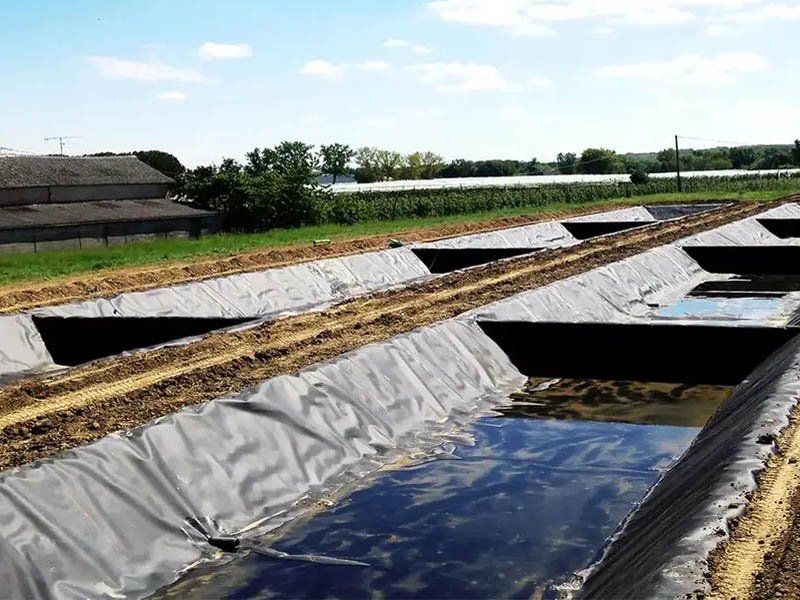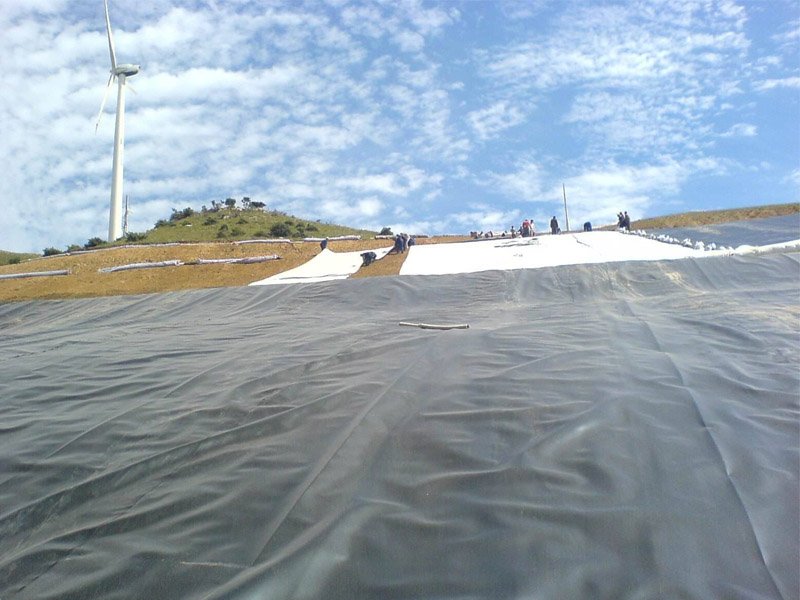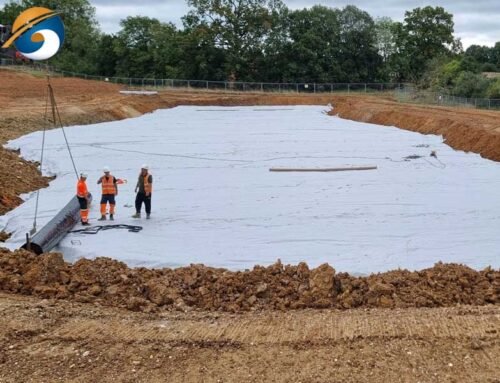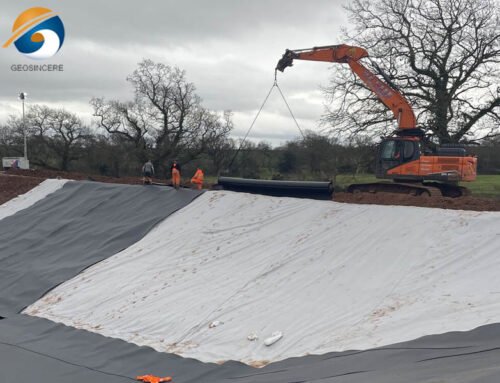Geomembrane 1.5mm as know as HDPE Geomembrane,is a type of high-density polyethylene (HDPE) liner material that is 1.5 millimeters thick. It is commonly used in construction projects for waterproofing, soil stabilization, and waste management. The thickness provides excellent durability and resistance to chemicals, UV radiation, and temperature fluctuations.GEOSINCERE Geomembrane is a robust and reliable HDPE liner that offers long-lasting protection against water seepage and environmental damage. Its versatility makes it suitable for various applications, including aquaculture ponds, landfill liners, and reservoirs.
1. What Is Geomembrane 1.5mm?
A 1.5mm geomembrane typically refers to a geosynthetic material that is 1.5 millimeters thick. This thickness is commonly used in various civil engineering and environmental projects for its balance of flexibility and strength. Geomembranes serve as impermeable barriers to contain liquids or gases in applications such as landfill liners, water storage facilities, and hazardous waste containment areas. The 1.5mm thickness provides a reliable level of protection against punctures, chemical degradation, and UV exposure, making it suitable for a wide range of geotechnical applications where effective containment is essential.
The material’s durability and resistance to environmental factors make it a versatile choice for applications demanding reliable containment properties. Whether used in mining operations, agricultural ponds, or industrial facilities, a 1.5mm geomembrane provides a robust barrier that helps prevent seepage and contamination, ensuring the integrity and safety of the underlying structures and the surrounding environment.


2. What Are Characteristics Of Geomembrane 1.5mm?
A 1.5mm geomembrane possesses several key characteristics that make it suitable for various applications in civil engineering, environmental protection, and geotechnical projects. Here are some common characteristics of a 1.5mm geomembrane:
2.1 Geomembrane 1.5mm – Thickness
The 1.5mm thickness offers an optimal balance between flexibility and structural strength, meeting diverse engineering needs. Additionally, this specific thickness maintains sufficient pliability while still resisting punctures and tears effectively. Moreover, it provides moderate to high impermeability, reliably preventing fluid migration in containment applications. Consequently, engineers frequently select this thickness for projects requiring both durability and performance. Ultimately, these combined characteristics make 1.5mm geomembranes a versatile solution for water management and environmental protection systems.
2.2 Geomembrane 1.5mm – Material Composition
Manufacturers commonly produce geomembranes from high-density polyethylene (HDPE), low-density polyethylene (LDPE), polyvinyl chloride (PVC), or ethylene propylene diene monomer (EPDM), each offering distinct advantages. HDPE provides exceptional chemical resistance and durability, while LDPE offers greater flexibility for certain applications. Additionally, PVC geomembranes demonstrate excellent UV stability and adaptability to temperature variations. EPDM rubber, on the other hand, delivers superior elasticity and weather resistance. Engineers consequently select these different materials based on specific project requirements involving chemical exposure, environmental conditions, and mechanical stresses.
2.3 Geomembrane 1.5mm – Impermeability
A 1.5mm geomembrane is designed to be impermeable, effectively preventing the passage of liquids or gases through its structure. This characteristic is crucial for containment applications where leakage must be avoided.
2.4 Geomembrane 1.5mm – Durability
Geomembranes effectively resist punctures from sharp objects and rough surfaces during installation and use. Additionally, their durable construction prevents tears even under significant stress or movement. Moreover, these materials actively withstand chemical degradation from acids, alkalis, and other corrosive substances. Consequently, they maintain their structural integrity in extreme weather conditions and challenging environments. This combination of properties ultimately ensures reliable, long-term performance in demanding engineering applications.
2.5 Geomembrane 1.5mm – Flexibility
Despite its thickness, a 1.5mm geomembrane remains flexible, allowing it to conform to the shape of the underlying surface and accommodate ground movement without compromising its integrity.
2.6 Geomembrane 1.5mm – UV Resistance
Many geomembranes are UV stabilized to withstand prolonged exposure to sunlight without significant degradation, making them suitable for outdoor applications.
2.7 Geomembrane 1.5mm – Installation Friendliness
Geomembranes feature lightweight materials and flexible designs that significantly simplify the installation process. Additionally, their roll-out format enables quick deployment across large project areas with minimal labor requirements. Moreover, installers can easily seam and weld the material using standard equipment, ensuring secure connections. Consequently, this efficiency reduces project timelines while maintaining high quality standards. Ultimately, these installation advantages make geomembranes a practical solution for diverse containment applications.
3. What Are Applications Of Geomembrane 1.5mm?
Geomembranes that are 1.5mm thick are used in many projects because of their special properties. They are often used for:
3.1 Landfill Liners
Geomembranes function as protective layers in landfills, blocking the flow of polluted liquid. This containment is crucial to avoid soil and groundwater contamination, thereby securing environmental well-being.
3.2 Pond and Reservoir Liners
1.5mm geomembranes are used in ponds, reservoirs, and water storage projects to form leak-proof barriers. These barriers stop water loss and manage water effectively.
3.3 Mining Applications
Geomembranes are utilized in mining operations for applications such as tailings ponds, heap leach pads, and containment structures to manage and contain industrial waste materials.
3.4 Agricultural Ponds
Geomembranes are used in agricultural settings for lining irrigation ponds, manure storage facilities, and other containment structures to prevent seepage and protect groundwater quality.
3.5 Secondary Containment
1.5mm geomembranes are employed in secondary containment systems for storing hazardous materials, chemicals, or fuel, providing an additional layer of protection against leaks and spills.
3.6 Waste Water Treatment
Geomembranes are used in waste water treatment facilities to line lagoons, tanks, and other structures, preventing the infiltration of contaminants into the soil.
3.7 Canal and Channel Linings
Geomembranes effectively line canals and channels to create reliable water barriers that prevent seepage. Additionally, they maintain smooth surfaces in ditches that promote efficient water flow for optimal irrigation performance. Moreover, their impermeable nature significantly reduces water loss in conveyance systems while withstanding constant hydraulic pressure. Consequently, engineers frequently specify geomembranes for agricultural and municipal water management projects. Ultimately, these lining solutions deliver long-term water conservation benefits while requiring minimal maintenance.
3.8 Environmental Protection
Geomembranes are used in environmental protection projects such as capping contaminated sites, lining industrial storage facilities, and creating barriers in remediation projects to contain and manage pollutants.


4. How To Right Install A Geomembrane 1.5mm?
Properly installing a 1.5mm geomembrane involves a series of essential steps to ensure effectiveness and longevity.
Begin by meticulously preparing the surface where the geomembrane will be placed.
Next, systematically unroll the geomembrane over the designated area, ensuring a smooth and wrinkle-free application.
Carefully fit and seam the geomembrane to prevent any leaks or gaps.
Secure the edges firmly using appropriate anchoring methods to keep the geomembrane in place.
Conduct thorough leak testing to verify the integrity of the installation.
Cover the geomembrane with protective materials to shield it from potential damage.
Regularly inspect and maintain the geomembrane to uphold its functionality and durability over time.
5. Summary
Geomembrane 1.5mm offers durability and versatility, making it perfect for preventing leaks and safeguarding the environment. Its key features include impermeability and chemical resistance, suitable for applications like landfill liners and water storage. By acting as a barrier, it protects soil and water, supporting ecological health. Proper installation is vital for its effectiveness in these critical projects.
GEOSINCERE has been committed to producing and supplying a variety of geosynthetic products, including textured geomembranes, since its establishment in 2007. Our product range features geotextiles, geomembranes, geogrids, geocells, geosynthetic clay liners, and drainage boards. We serve customers across more than 100 countries.GEOSINCERE Geosynthetics , we not only provide high-quality geosynthetic materials but also offer professional design and installation services. Customized solutions, including OEM and ODM services, are available upon request.
If you have any questions or information requests, please contact us and we will respond promptly.





